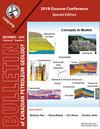柴达木盆地第四纪生物气
Q3 Earth and Planetary Sciences
引用次数: 7
摘要
柴达木盆地东部三湖坳陷第四系七格泉组为陆相碎屑沉积体系,具有丰富的生物气资源。三湖坳陷具有快速沉积、埋深浅、富有机质、高孔隙度/渗透率、盐化沉积环境等有利的地质历史和格架特征。气体以甲烷(C2+3<0.5%)、微量乙烷/丙烷(C2+3<0.5%)和少量非烃气体(CO2 <0.5%)为主;N2 < 3%)。甲烷的δ13C1值为−70 ~−62‰,δD1值为−240 ~−220‰,表明甲烷是通过CO2还原途径生成的。乙烷非常轻,δ13C2值为−50 ~−44‰;丙烷的δ13C3值为−34 ~−32‰。推断乙烷和丙烷在低有机成熟度水平下具有相同的热催化成因,与甲烷的生物成因无关。生物甲烷与含盐地层水平衡。地层水地球化学数据,包括稳定同位素值(δD和δ18O)和36Cl年龄,表明最近受到大气水的稀释。甲烷生成目前是活跃的,这表明存在丰富的氢和微生物。最近和正在进行的生物气生成模型解释了为什么生物气聚集在浅层地质环境中如此丰富,而浅层地质环境的聚集和保存条件被认为相对较差。本文章由计算机程序翻译,如有差异,请以英文原文为准。
Quaternary biogenic gases in the Qaidam Basin, Western China
Abstract The Quaternary Qigequan Formation, a continental clastic sedimentation system in Sanhu Depression of eastern Qaidam Basin, west-central China, contains abundant biogenic gas resources. Favorable characteristics of the Sanhu Depression’s geological history and framework responsible for biogenic gas production include rapid sedimentation, shallow burial depth, organic-rich sediments, high porosity/permeability, and a saline depositional environment. Gases are dominated by methane (>99%), with trace ethane/propane (C2+3<0.5%) and minor non-hydrocarbon gases (CO2 <0.5%; N2 <3%). Methane has δ13C1 values of −70 to −62‰ and δD1 values of −240 to −220‰, suggesting generation following a CO2 reduction pathway. Ethane is very light with δ13C2 values of −50 to −44‰; propane δ13C3 values range from −34 to −32‰. Ethane and propane are inferred to have the same thermocatalytic origin under low organic maturity levels and are unrelated to the biogenic origin of methane. Biogenic methane is equilibrated with the saline formation waters. The formation water geochemistry data, including stable isotope values (δD and δ18O) and 36Cl age, suggest recent dilution by meteoric waters. Methanogenesis is currently active, as indicated by the presence of both abundant hydrogen and microbes. The recent and ongoing biogenic gas generation model proposed explains why biogenic gas accumulations are so abundant in a shallow geological setting where the conditions for accumulation and preservation are otherwise considered relatively poor.
求助全文
通过发布文献求助,成功后即可免费获取论文全文。
去求助
来源期刊

Bullentin of Canadian Petroleum Geology
Earth and Planetary Sciences-Geochemistry and Petrology
CiteScore
2.50
自引率
0.00%
发文量
0
期刊介绍:
The Bulletin of Canadian Petroleum Geology is a peer-reviewed scientific journal published four times a year. Founded in 1953, the BCPG aims to be the journal of record for papers dealing with all aspects of petroleum geology, broadly conceived, with a particularly (though not exclusively) Canadian focus. International submissions are encouraged, especially where a connection can be made to Canadian examples.
 求助内容:
求助内容: 应助结果提醒方式:
应助结果提醒方式:


